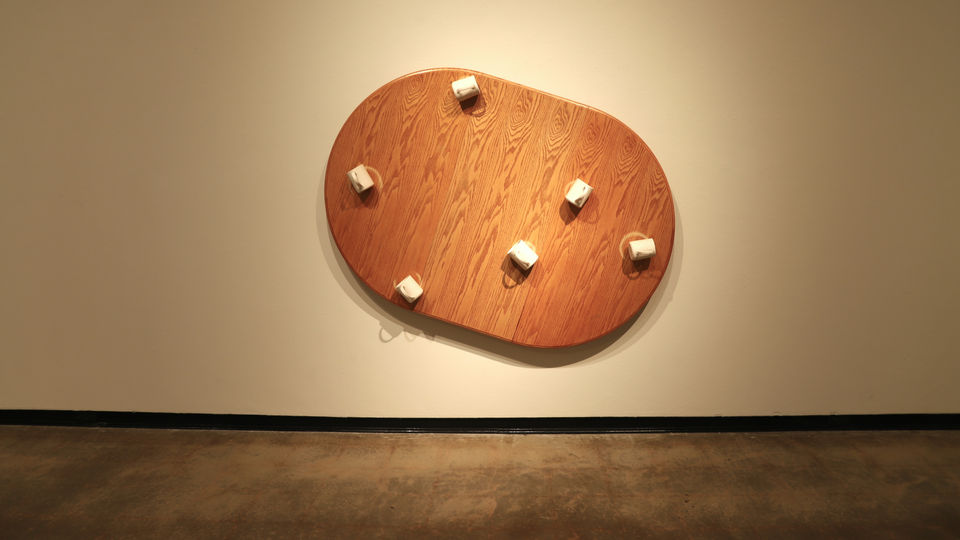MFA THESIS EXHIBITION II
April 9 – April 23, 2021


Curatorial Statement
As the guest curator for the SA+AH MFA Thesis Exhibition, Untitled 2,
I sought to involve the Art and Art History Department’s graduating
students in a process very similar to the one that they will be involved in
as they begin to interact with institutional curators as their professional
careers unfold. This was a process that involved studio visits; ongoing
dialogues around the presentation and framing of their work, including
conversations regarding the history of the media in which they work
and the themes that they were addressing; and finally, a search for
connections between all their projects that would produce a coherent
exhibition, while respecting their distinct points of view by not forcing
them into a prescribed theme that would reflect my current interests
more than theirs. If there was a didactic dimension to the exercise it
arose from placing the students in a situation that mimics what will soon
become a central part of their work life: exchanges with curators, which
require a set of skills that are applicable to similar exchanges with other
nstitutional figures, art writers, and collectors.
Although an overarching theme wasn’t established for the exhibition,
there certainly were points of intersection to highlight between the
works presented, particularly around flows of matter and labile forms. In
Monsur Awotunde's work, remnants that index the global flow of goods,
and the movement of foodstuffs on the African continent in particular,
are recast into sprawling paintings and painterly accumulations. A
geopolitical undercurrent is also present in Cindy Leung’s ceramics, as
these explore British imperial history and the particular role that tea
plays in it.
Aimee Marcinko’s ceramic installation concerns itself not with the flow
of commodities but of biological matter, employing light to signal the
dynamic systems of organic production. Erin Holmes, also employing
ceramics, revisits the connection between biomorphic forms and feminist
discourses, while Jasmine Ramos undertakes a similar operation through
embroidery and other textile-based practices. In Claire Lenahan’s ceramics
standard elements of everyday receptacles are given mutant traits and
placed on “misused” tables, inviting viewers to engaged with them and
their queer formality.
Gean Moreno, Guest Curator
The exhibition will be guest-curated by Gean Moreno, curator and director of the Knight Foundation Art + Research Center at the Institute of Contemporary Art, Miami. Moreno says that he hoped to “involve the Art and Art History Department’s graduating students in a process very similar to the one that they will be involved in as they begin to interact with institutional curators as their professional careers unfold.” The exhibitions will feature work in a diverse array of media, including graphic design, ceramics, installation, painting, printmaking, sculpture, and video.
MASTER OF FINE ARTS CANDIDATES EXHIBITION II
MONSUR AWOTUND
Monsur Awotunde’s work recasts remnants that index the global flow of goods, and the movement of foodstuffs on the African continent in particular into sprawling paintings and painterly accumulations.
ERIN HOLMES
Erin Holmes’ ceramics explore the connection between biomorphic forms and feminist discourses. Holmes sculpts numerous vessels, bottles, decanters, and cups, intended to challenge our understanding of gender, sexuality, and the stigma often associated with alternative sexual behaviors or relations.
CINDY LEUNG
Cindy Leung’s works utilize ceramics and textiles in combination to explore concepts of cultural hybridity and the effects of colonialism on personal identity. In doing so, she draws upon her own daily experience, which involves constant code switching within a network of Chinese, British, and American cultural influence.
CLAIRE LENAHAN
In Claire Lenahan’s ceramics standard elements of everyday receptacles are given mutant traits and placed on “misused” tables, inviting viewers to engage with them and their queer formality. These seemingly familiar, functional objects change their expected design to challenge the user.
AIMEE MARCINKO
Aimee Marcinko creates an immersive and responsive installation of ceramic sculpture and dramatic LED lighting that serves as a striking reminder of nature’s intelligence and its symbiotic relationships with human kind.
JASMINE RAMOS
Asking, “How can I use materiality to allude to the construction or fabrication of queer identity?” Jasmine Ramos examines feminist dialogue through embroidery and other textile-based practices. Her work consists of two-dimensional wall-hung fabric pieces concerning her own bodily experiences as a queer person.



















